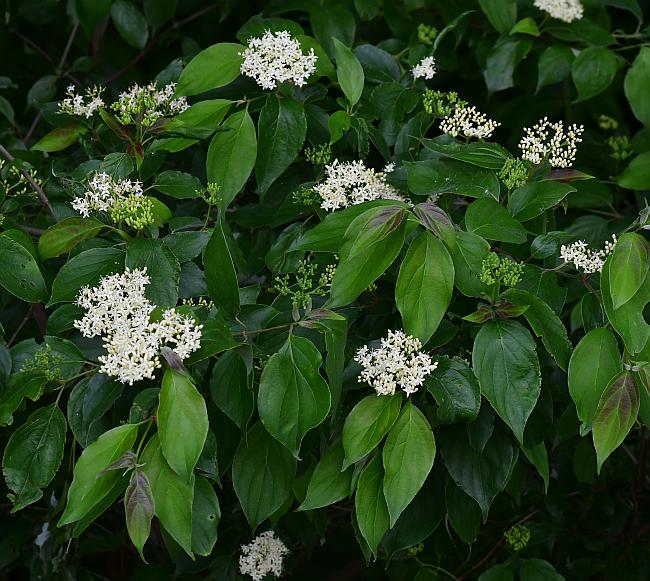Cornus drummondii C.A. Mey.
Rough-Leaved Dogwood

Native
CC = 2
CW = 0
MOC = 87
© SRTurner
Cornus drummondii C.A. Mey.Rough-Leaved Dogwood | |
 |
Native CC = 2 CW = 0 MOC = 87 |
© SRTurner |
|
Family - Cornaceae Habit - Shrubs, or small trees to 6 m tall, often colonial. Stems - Twigs green to reddish brown, densely hairy when young, becoming glabrous or nearly so with age, the pith white to brown. Bark usually with shallow fissures, the ridges becoming divided into thin, irregular plates, grayish brown, usually with small, slightly raised, lighter dots.
Leaves - Opposite, petiolate, simple, well-dispersed along branches. Petioles 1.0-1.5 cm long. Leaf blades 6-11 cm long, 3-7 cm wide, lanceolate to elliptic or broadly ovate, rounded or angled at the base, tapered to a sharply pointed tip, the surfaces moderately pubescent with mostly somewhat spreading, V-shaped or Y-shaped hairs, the upper surface moderately to strongly roughened to the touch, the undersurface softer-hairy and usually with microscopic white papillae, some of the hairs ascending to erect, the lateral veins usually 3 or 4 pairs, these mostly arising from the basal half of the blade.
Inflorescence - Appearing more or less umbellate, to 8 cm broad, usually shallowly convex, the bracts absent or rarely a few at the branch points and these minute and scalelike, the flower stalks 2-8 mm long, hairy, becoming reddish brown to purplish brown as the fruits mature.
Flowers - Sepals 4, 0.4-1.0 mm long. Petals 4, 2.5-4.0 mm long, narrowly oblong-lanceolate, glabrous internally, appressed-pubescent externally, white to cream-colored. Style 2.5-3.5 mm long, relatively slender, not broadened toward the tip Stamens 4, alternating with the corolla lobes, erect to spreading. Filaments white, glabrous, 3-4 mm long. Anthers yellow, 2 mm long. Style 1, erect, 3 mm long, white, glabrous, surrounded basally by a thick light-pinkish nectary. Stigma greenish, capitate. Ovary inferior, 2-locular, with 2 ovules. Placentation axile.
Fruits - Globose drupes 4-7 mm in diameter, spherical, white, occasionally mottled with dark blue. Stone smooth or inconspicuously grooved.
Flowering - May - June. Habitat - Forests, margins of glades, prairies, bluffs, streambanks, marshes, fields, roadsides. Origin - Native to the U.S. Lookalikes - Cornus foemina. Other info. - When many people hear "dogwood," they think of the most well-known member of the genus, flowering dogwood (Cornus florida). But in fact, C. drummondii is the most common species of dogwood in Missouri, occurring in all parts of the state. Its U.S. distribution is mainly midwestern, ranging south to the Gulf Coast. When in bloom, it is easily recognized as a dogwood by the characteristic inflorescences of (mostly) 4-parted flowers. However, differentiation from the closely related C. foemina can be difficult. Both Flora of North America and Weakley's Flora of the Southern and Mid-Atlantic States assert that Cornus drummondii has erect hairs on the leaf undersurface, whereas in C. foemina these are appressed. Also, C. drummondii leaves are usually roughened on the upper surface, though this character is variable and requires some experience for confident interpretation. To add to the confusion, hybrids with other species can occur, producing forms with intermediate or contradictory character states. Note that the key to Cornus in Yatskievych's Flora of Missouri erroneously states that Cornus drummondii has glabrous young twigs, when in fact they are hairy. Photographs taken off Hwy K, Boone County, MO., 5-29-04 (DETenaglia); also at Weldon Spring Conservation Area, St. Charles County, MO, 5-9-2012, near Labadie, Franklin County, MO, 4-25-2021 and 8-5-2020, and along the Katy Trail near Dutzow, Warren County, MO, 6-6-2021 (SRTurner). |